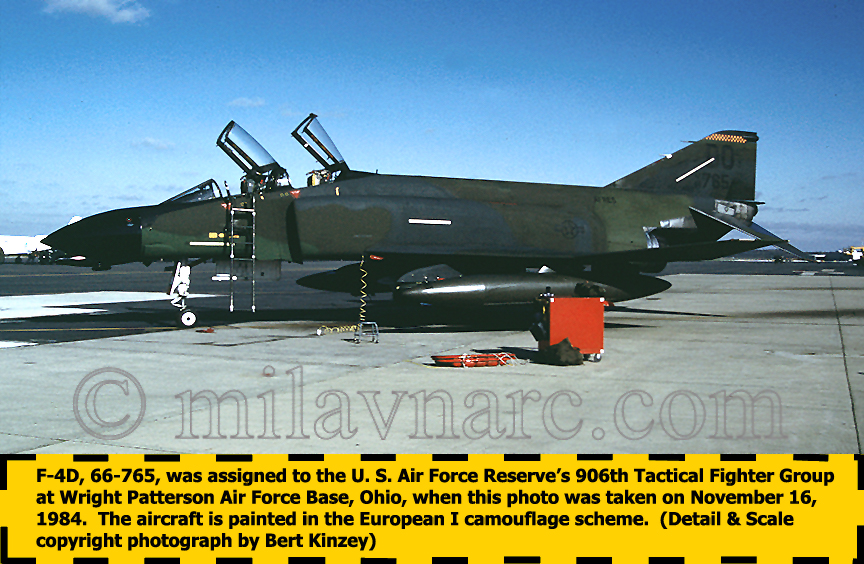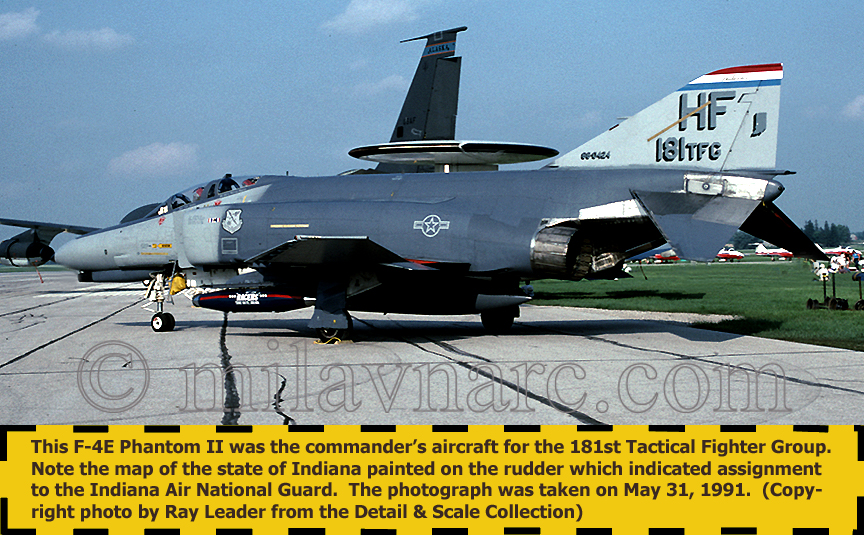F-4 Phantom (USAF) Information File:
During the early 1950s, early U. S. Air Force jet fighters were generally superior to those in the inventory of naval aviation as the Navy learned to adapt jet aircraft for operations aboard aircraft carriers. Shipboard operations with jets required much more planning and development than was necessary for fighters that operated only from land bases. But the Navy and the American aircraft industry worked together brilliantly to solve these problems with innovative designs and new features for aircraft and aircraft carriers alike. When the Vought F8U Crusader entered service in the late 1950s, the Navy had caught up and had a jet fighter that was the equal of any in the U. S. Air Force.
Shortly after the 1960s began, what had been unthinkable only a few years earlier happened when the Navy placed the McDonnell F-4 Phantom II in service. Designed as an all-weather fleet defense interceptor, the Phantom proved to be a very capable fighter-bomber, being able to deliver a wide range of bombs, rockets, and missiles against ground targets as well as intercept any hostile intruders that might threaten the fleet. The Navy’s hot new fighter began to break almost all of the existing performance records for fighter aircraft. So powerful and capable was the F-4 that the Air Force had no choice but to evaluate the new fighter for its own service.
The Air Force soon placed an order for its own version of the Phantom, initially designated the F-110A and named Spectre. Primary among the changes made by the Air Force were the addition of fight controls in the rear cockpit, different avionics to enhance the ground attack capability, and larger main landing gear wheels and tires for land operations. The last of these necessitated increasing the thickness of the wings near their roots to accept the thicker wheels. Since the Air Force favored the high-speed boom method of in-flight refueling, the Navy’s retractable refueling probe was deleted, and a receptacle for the boom was installed on the spine of the fuselage. This receptacle remained closed except when it was needed for in-flight refueling operations.
The Air Force also ordered an all-weather reconnaissance version which was initially designated the RF-110A. Although the primary role of this version was photographic reconnaissance, it also retained the capability to deliver a tactical nuclear weapon.
The first F-110A made its initial flight on May 27, 1963, and shortly thereafter, the designation was changed to F-4C as the Department of Defense ordered the standardization of aircraft designations within the U. S. military. RF-110As were redesignated RF-4Cs. The name, Spectre, was dropped, and all F-4s became known as Phantoms. Officially, the nickname was Phantom II, acknowledging McDonnell’s previous jet fighter, the FH-1 Phantom. A total of 583 F-4Cs entered the Air Force inventory along with 503 RF-4Cs.
The second fighter variant ordered by the U. S. Air Force was the F-4D. Externally, it looked much the same as the previous F-4C, but the easiest way to tell the difference was to look at the infrared housing under the radome. F-4Cs had a smooth housing, and although some early F-4Ds had no fairing at all, most had a fairing with a noticeable bump on the underside. The configuration of the hump would change over the service life of the F-4D, but it was always there in one form or another.
The F-4D had improved avionics for ground attack missions, but was basically similar to the previous F-4C. The AN/APQ-109A radar replaced the APQ-100 used in the F-4C. The AN/APQ-109A was both smaller and lighter than the previous radar, and it was part of the AN/APA-165 radar set group which provided air-to-ground ranging capability. The AN/ASQ-91 weapons release system greatly improved the delivery of air-to-ground weapons. The F-4D became the first fighter to use “smart” weapons in the form of laser-guided bombs. Later, electro-optical weapons were delivered from F-4Ds as well. Another improvement to the F-4D was the addition of the AN/ASG-22 lead-computing gun sight which enhanced air-to-air capabilities.
During the war in Vietnam, the Phantom’s major shortcoming became obvious. It did not have an internal gun system for air-to-air combat, and the use of external gun pods proved less than satisfactory. As a result, the Air Force ordered the F-4E variant of the Phantom. This version was equipped with a six-barrel, 20-mm, Vulcan cannon mounted internally in the nose. The radar in the F-4E was the AN/APQ-120, which, because of its solid-state circuitry, was smaller and lighter than the two radars used in the F-4C and F-4D. The engines were upgraded to the General Electric J79-GE-17, and these had longer afterburner nozzles than those used on the previous versions of the Phantom.
The final variant of the Phantom to enter service with the U. S. Air Force was the F-4G Wild Weasel, although these aircraft were not delivered as new production airframes. A total of 116 F-4Gs were modified from existing F-4Es in the Air Force inventory. Like the F-4E, the F-4G was developed from a lesson learned in Southeast Asia. The need to suppress radar controlled anti-aircraft missiles and gun systems caused an ongoing effort to develop aircraft and systems specifically designed and equipped to perform this vital role. During the war, F-100F Super Sabres, F-105F and –G Thunderchiefs, and even a few F-4Cs had been modified for this dangerous but necessary role. Experience gained from operations with these aircraft resulted in the development of the F-4G.
Deliveries of the F-4G began in April 1978, well after the war in Vietnam had ended. The most noticeable differences between the F-4G and the F-4E were the chin pod full of antennas, that replaced the fairing for the 20-mm cannon in the F-4E, and a second pod mounted at the top of the vertical tail. A total of 52 new antennas, associated with the APR-38 radar homing and warning system, were added to the F-4G. All of these systems were operated by the crewman in the rear cockpit who was known as the “Bear.”
The F-4G’s primary weapons were the AGM-45 Shrike, the AGM-78 Standard, and the AGM-88 HARM anti-radiation missiles, although it could carry most of the other weapons that were certified for use with the F-4E. F-4Gs were fitted with slatted wings, a feature found on some late F-4Es as well. F-4Gs were still in the inventory when Operation Desert Storm took place in 1991, and they provided air defense suppression for U. S. Air Force and Coalition aircraft as they took part in the campaign to drive Iraqi out of Kuwait.
F-4E Phantom (307TH TFS):
307TH TFS F-4Es RETURN FROM UDORN, THAILAND & VIETNAM NOVEMBER 3, 1972
On November 3, 1972, the 307th Tactical Fighter Squadron of the 31st Tactical Fighter Wing returned home to Homestead Air Force Base, Florida. They had been deployed to Vietnam, operating out of Udorn, Thailand. Among the aircraft were several MiG killers, and many of the F-4Es were painted with shark mouths and eyes on the nose. All were painted in the Standard Southeast Asia Camouflage Scheme, which was the norm for most F-4 in USAF service at that time.
In 1972, the standard tail code of the 307th TFS was ZF, but during the deployment, several replacement aircraft were transferred to the squadron from the 555th Tactical Fighter Squadron which had flown the aircraft on earlier deployment to Vietnam. While serving with the 307th TFS, these Phantoms retained the ED tail code that was assigned when they were flying with the 555th TFS.
As these F-4Es returned home to the base, and the pilots and weapons systems officers rejoined their families, Warren Munkasy and Bert Kinzey photographed the aircraft and the event. The photographs in this photo set are several of the photographs taken that day and the day after. They are some of the oldest originalphotographs in the Detail & Scale collection, being almost forty years old. Most of these examples were taken by Warren Munkasy, because he had the better camera at that time.
We acknowledge and remember the crews who flew these aircraft and maintained them during the war in Vietnam. When these photos were taken they were in their twenties, thirties and forties. Today, as this set is posted in 2011, they are all senior citizens.
U. S. Air Force F-4 Phantoms
General Photo Set:
This photo set contains general photographs of F-4 Phantoms not included in the subject-specific F-4 Phantom photo sets.










































